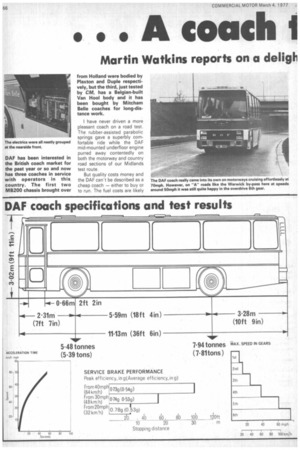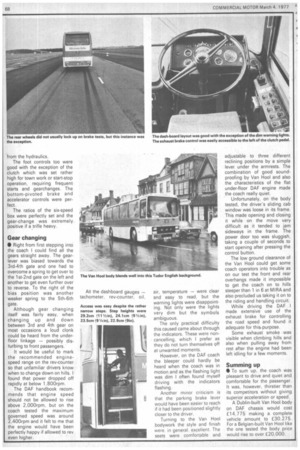• • . A coach I thirst after
Page 72

Page 73

Page 74

If you've noticed an error in this article please click here to report it so we can fix it.
Martin Watkins reports on a deligh ul but fuel-hungry continental coach
DAF has been interested in the British coach market for the past year or so and now has three coaches in service with operators in this country. The first two MB200 chassis brought over I have never driven a more pleasant coach on a road test. The rubber-assisted parabolic springs gave a superbly comfortable ride while the DAF mid-mounted underfloor engine purred away contentedly on both the motorway and country road sections of our Midlands test route.
But quality costs money and the DAF can't be described as a cheap coach — either to buy or to run. The fuel costs are likely to be offset by reduced maintenance costs with the robust heavyweight chassis, but this is something that only time will tell.
Fuel consumption • The fuel consumption of the DAF hardly varied at all between the motorway and country sections of the test route. Overall it returned 28.68 litres per 100km (9.85mpg) which does not compare very favourably with other coaches tested by CM recently.
The overall weight of the DAF, loaded to represent a full complement of passengers and luggage, was 13.42 tonnes (13.20 tons).
Brakes
• Getting away from fuel consumption to acceleration time to 50mph, the DAF produced the same figure as the Ford 81114, was faster than the Bedford YMT but slower than the Volvo B58.
Although these test results were a little disappointing the DAF came into its own on the road section of the test route.
The full-air brakes, very light, gave me the feeling that they could cope easily with any emergency. The test track brake tests produced a stopping distance of 98ft from 40mpg.
The front brakes never locked up although on one of the test stops the back brakes locked. Even so the coach always pulled .up in a straight line under perfect control.
Steering was admirable as the hydraulic power steering needed little effort and had enough sensitivity to give per fect control on the tortuous roads between Stratford-onAvon and Burford and between High Wycombe and Hemel Hempstead. One small criticism was the strange underfloor noises which I presume came from the hydraulics.
The foot controls too were good with the exception of the clutch which was set rather high for town work or start-stop operation, requiring frequent starts and gearchanges. The bottom-pivoted brake and accelerator controls were perfect.
The ratios of the six-speed box were perfectly set and the gear-change was extremely positive if a trifle heavy.
Gear changing
• Right from first stepping into the coach I could find all the gears straight away. The gearlever was biased towards the 3rd-4th gate and one had to overcome a spring to get over to the 1st-2nd gate on the left and another to get even further over to reverse. To the right of the bias position was another weaker spring to the 5th-6th gate.
Although gear changing itself was fairly easy, when changing up and down between 3rd and 4th gear on most occasions a loud clonk could be heard from the underfloor linkage -possibly disturbing to front passengers.
It would be useful to mark the recommended enginespeed range on the rev-counter so that unfamiliar drivers know when to change down on hills. I found that power dropped off rapidly at below 1,800rpm.
The DAF handbook recommends that engine speed should not be allowed to rise above 2,000rpm, but on the coach tested the maximum governed speed was around 2,400rpm and it felt to me that the engine would have been perfectly happy if allowed to rev even higher. All the dashboard gauges -tachometer, rev-counter, oil, air, temperature -were clear and easy to read, but the warning lights were disappointing. Not only were the lights very dim but the symbols ambiguous.
The only practical difficulty this caused came about through the indicators. These were noncancelling. which I prefer as they do not turn themselves off at unwanted moments.
However, on the DAF coach the bleeper could hardly be heard when the coach was in motion and as the flashing light was dim I often found myself driving with the indicators flashing.
Another minor criticism is that the parking brake lever would have been easier to reach if it had been positioned slightly closer to the driver.
Turning to the Van Hool bodywork the style and finish were in general. excellent, The seats were comfortable and
adjustable to three different reclining positions by a simple lever under the armrests. The combination of good soundproofing by Van Hool and also the characteristics of the flat under-floor DAF engine made the coach really quiet.
Unfortunately, on the body tested, the driver's sliding cab window was loose in its frame. This made opening and closing it while on the move very difficult as it tended to jam sideways in the frame. The power door too was sluggish, taking a couple of seconds to start opening after pressing the control button.
The low ground clearance of the Van Hool could get some coach operators into trouble as on our test the front and rear overhangs made it impossible to get the coach on to hills steeper than 1 in 6 at MIRA and also precluded us taking it on to the riding and handling circuit.
While driving the DAF I made extensive use of the exhaust brake for controlling the road speed and found it adequate for thispurpose.
Some exhaust smoke was visible when climbing hills and also when pulling away from rest after the engine had been left idling for a few moments.
Summing up
* To sum up, the coach was pleasant to drive and quiet and comfortable for the passenger. It was, however, thirstier than its competitors without giving superior acceleration or speed.
A Dublin-built Van Hool body on DAF chassis would cost £14,775 making a complete vehicle amount to £30,275. For a Belgian-built Van Hook like the one tested the body price would rise to over £20,000.


























































































































































